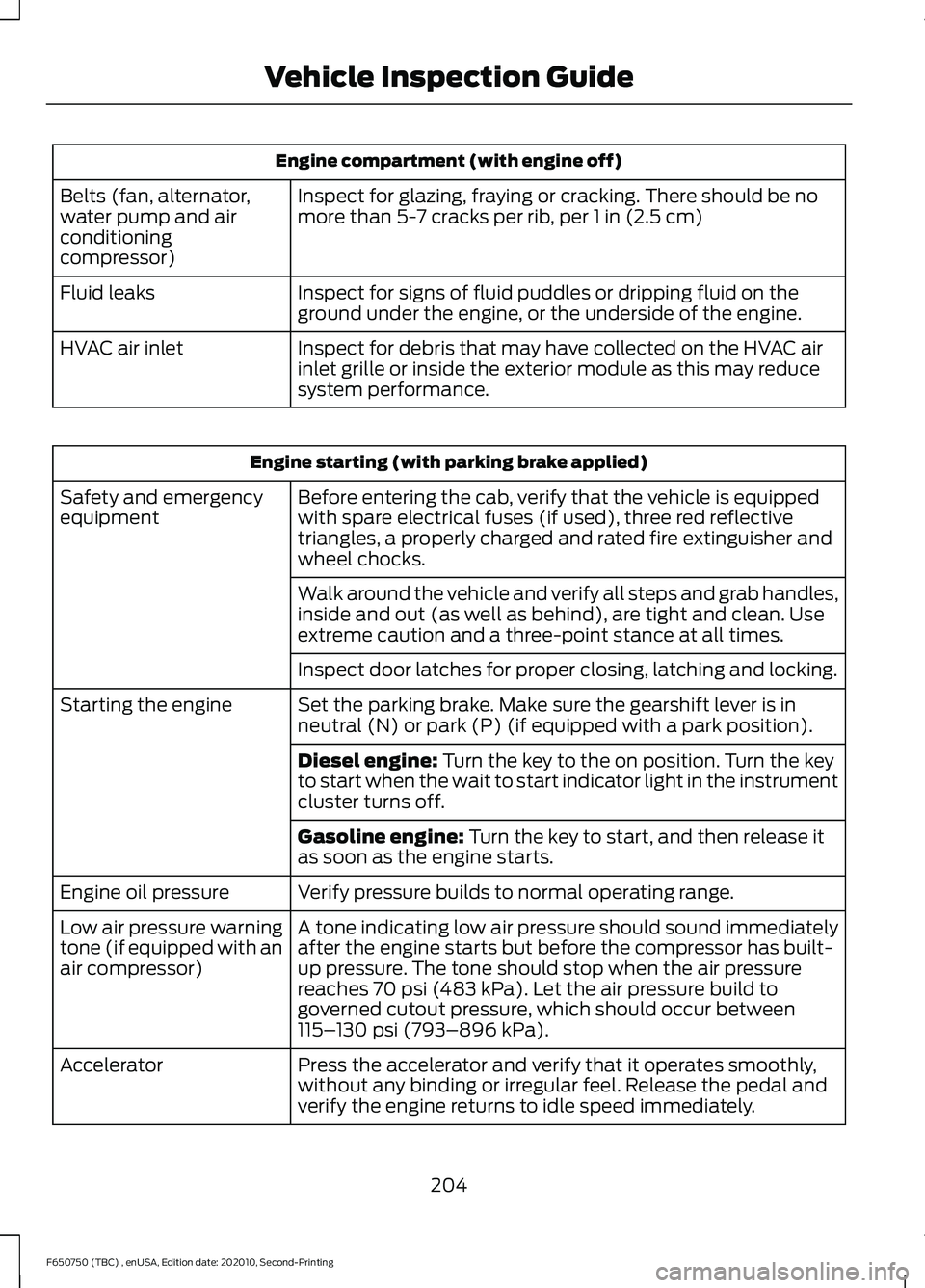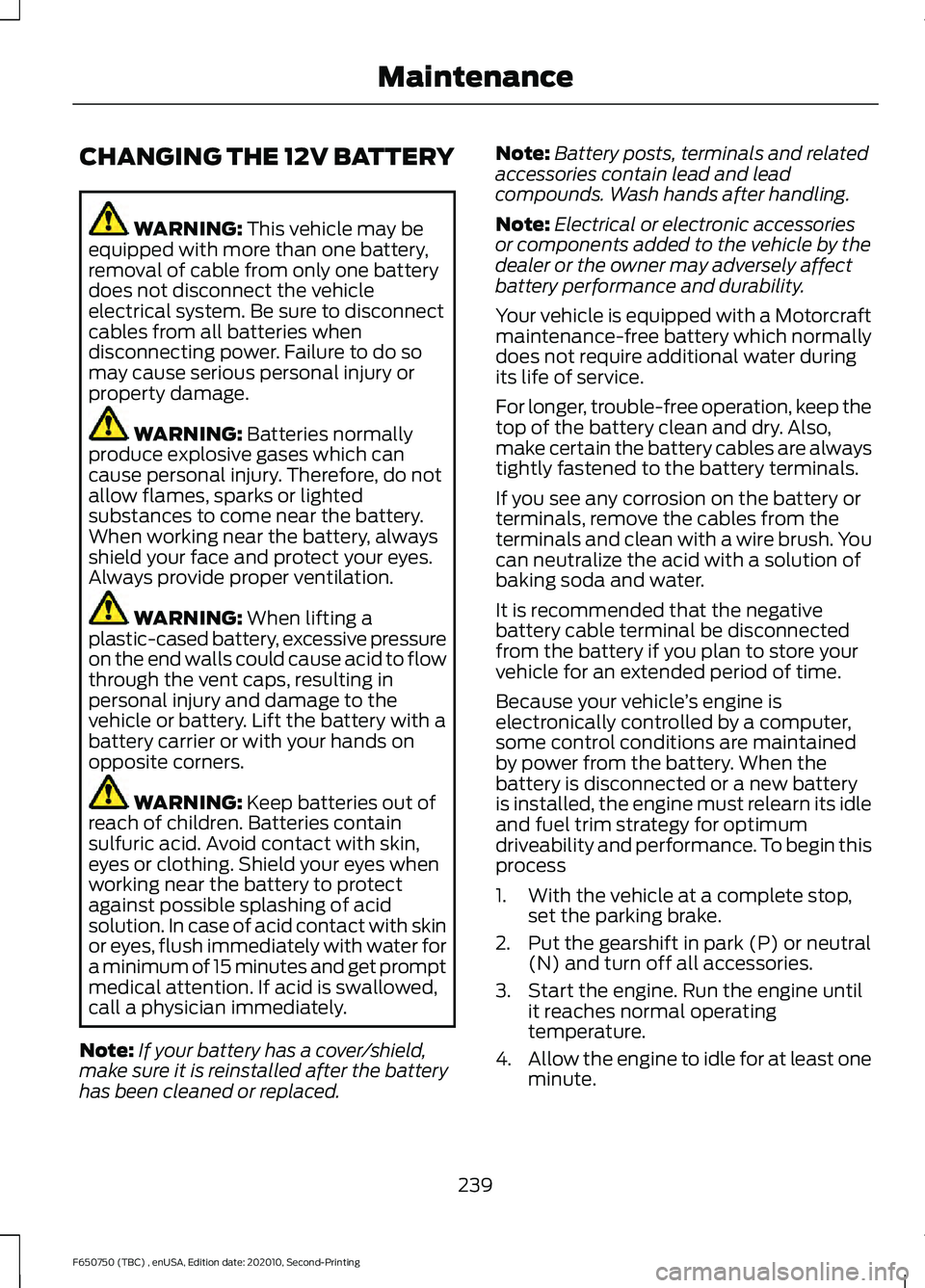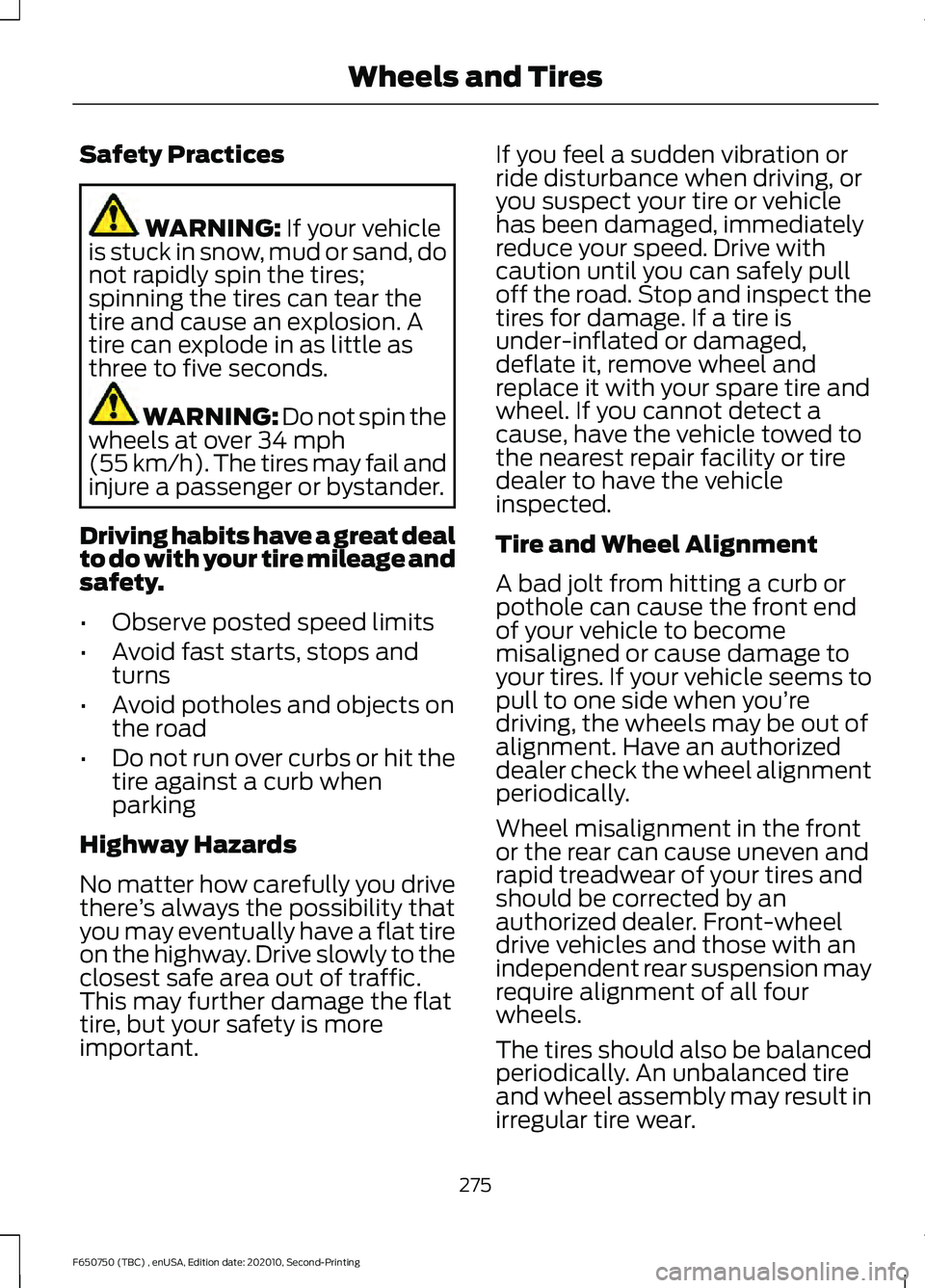2021 FORD F650/750 stop start
[x] Cancel search: stop startPage 207 of 390

Engine compartment (with engine off)
Inspect for glazing, fraying or cracking. There should be no
more than 5-7 cracks per rib, per 1 in (2.5 cm)
Belts (fan, alternator,
water pump and air
conditioning
compressor)
Inspect for signs of fluid puddles or dripping fluid on the
ground under the engine, or the underside of the engine.
Fluid leaks
Inspect for debris that may have collected on the HVAC air
inlet grille or inside the exterior module as this may reduce
system performance.
HVAC air inlet Engine starting (with parking brake applied)
Before entering the cab, verify that the vehicle is equipped
with spare electrical fuses (if used), three red reflective
triangles, a properly charged and rated fire extinguisher and
wheel chocks.
Safety and emergency
equipment
Walk around the vehicle and verify all steps and grab handles,
inside and out (as well as behind), are tight and clean. Use
extreme caution and a three-point stance at all times.
Inspect door latches for proper closing, latching and locking.
Set the parking brake. Make sure the gearshift lever is in
neutral (N) or park (P) (if equipped with a park position).
Starting the engine
Diesel engine:
Turn the key to the on position. Turn the key
to start when the wait to start indicator light in the instrument
cluster turns off.
Gasoline engine:
Turn the key to start, and then release it
as soon as the engine starts.
Verify pressure builds to normal operating range.
Engine oil pressure
A tone indicating low air pressure should sound immediately
after the engine starts but before the compressor has built-
up pressure. The tone should stop when the air pressure
reaches
70 psi (483 kPa). Let the air pressure build to
governed cutout pressure, which should occur between
115– 130 psi (793–896 kPa)
.
Low air pressure warning
tone (if equipped with an
air compressor)
Press the accelerator and verify that it operates smoothly,
without any binding or irregular feel. Release the pedal and
verify the engine returns to idle speed immediately.
Accelerator
204
F650750 (TBC) , enUSA, Edition date: 202010, Second-Printing Vehicle Inspection Guide
Page 242 of 390

CHANGING THE 12V BATTERY
WARNING: This vehicle may be
equipped with more than one battery,
removal of cable from only one battery
does not disconnect the vehicle
electrical system. Be sure to disconnect
cables from all batteries when
disconnecting power. Failure to do so
may cause serious personal injury or
property damage. WARNING:
Batteries normally
produce explosive gases which can
cause personal injury. Therefore, do not
allow flames, sparks or lighted
substances to come near the battery.
When working near the battery, always
shield your face and protect your eyes.
Always provide proper ventilation. WARNING:
When lifting a
plastic-cased battery, excessive pressure
on the end walls could cause acid to flow
through the vent caps, resulting in
personal injury and damage to the
vehicle or battery. Lift the battery with a
battery carrier or with your hands on
opposite corners. WARNING:
Keep batteries out of
reach of children. Batteries contain
sulfuric acid. Avoid contact with skin,
eyes or clothing. Shield your eyes when
working near the battery to protect
against possible splashing of acid
solution. In case of acid contact with skin
or eyes, flush immediately with water for
a minimum of 15 minutes and get prompt
medical attention. If acid is swallowed,
call a physician immediately.
Note: If your battery has a cover/shield,
make sure it is reinstalled after the battery
has been cleaned or replaced. Note:
Battery posts, terminals and related
accessories contain lead and lead
compounds. Wash hands after handling.
Note: Electrical or electronic accessories
or components added to the vehicle by the
dealer or the owner may adversely affect
battery performance and durability.
Your vehicle is equipped with a Motorcraft
maintenance-free battery which normally
does not require additional water during
its life of service.
For longer, trouble-free operation, keep the
top of the battery clean and dry. Also,
make certain the battery cables are always
tightly fastened to the battery terminals.
If you see any corrosion on the battery or
terminals, remove the cables from the
terminals and clean with a wire brush. You
can neutralize the acid with a solution of
baking soda and water.
It is recommended that the negative
battery cable terminal be disconnected
from the battery if you plan to store your
vehicle for an extended period of time.
Because your vehicle ’s engine is
electronically controlled by a computer,
some control conditions are maintained
by power from the battery. When the
battery is disconnected or a new battery
is installed, the engine must relearn its idle
and fuel trim strategy for optimum
driveability and performance. To begin this
process
1. With the vehicle at a complete stop, set the parking brake.
2. Put the gearshift in park (P) or neutral (N) and turn off all accessories.
3. Start the engine. Run the engine until it reaches normal operating
temperature.
4. Allow the engine to idle for at least one
minute.
239
F650750 (TBC) , enUSA, Edition date: 202010, Second-Printing Maintenance
Page 278 of 390

Safety Practices
WARNING: If your vehicle
is stuck in snow, mud or sand, do
not rapidly spin the tires;
spinning the tires can tear the
tire and cause an explosion. A
tire can explode in as little as
three to five seconds. WARNING:
Do not spin the
wheels at over 34 mph
(55 km/h). The tires may fail and
injure a passenger or bystander.
Driving habits have a great deal
to do with your tire mileage and
safety.
• Observe posted speed limits
• Avoid fast starts, stops and
turns
• Avoid potholes and objects on
the road
• Do not run over curbs or hit the
tire against a curb when
parking
Highway Hazards
No matter how carefully you drive
there ’s always the possibility that
you may eventually have a flat tire
on the highway. Drive slowly to the
closest safe area out of traffic.
This may further damage the flat
tire, but your safety is more
important. If you feel a sudden vibration or
ride disturbance when driving, or
you suspect your tire or vehicle
has been damaged, immediately
reduce your speed. Drive with
caution until you can safely pull
off the road. Stop and inspect the
tires for damage. If a tire is
under-inflated or damaged,
deflate it, remove wheel and
replace it with your spare tire and
wheel. If you cannot detect a
cause, have the vehicle towed to
the nearest repair facility or tire
dealer to have the vehicle
inspected.
Tire and Wheel Alignment
A bad jolt from hitting a curb or
pothole can cause the front end
of your vehicle to become
misaligned or cause damage to
your tires. If your vehicle seems to
pull to one side when you’re
driving, the wheels may be out of
alignment. Have an authorized
dealer check the wheel alignment
periodically.
Wheel misalignment in the front
or the rear can cause uneven and
rapid treadwear of your tires and
should be corrected by an
authorized dealer. Front-wheel
drive vehicles and those with an
independent rear suspension may
require alignment of all four
wheels.
The tires should also be balanced
periodically. An unbalanced tire
and wheel assembly may result in
irregular tire wear.
275
F650750 (TBC) , enUSA, Edition date: 202010, Second-Printing Wheels and Tires
Page 388 of 390

Spare Wheel
See: Changing a Road Wheel........................ 277
Special Notices................................................18
New Vehicle Limited Warranty........................ 18
Notice to Owners of Pickup Trucks and Utility Type Vehicles........................................ 18
On Board Diagnostics Data Link Connector........................................................... 18
Special Instructions............................................. 18
Using your Vehicle as an Ambulance............19
Using Your Vehicle With a Snowplow...........19
Special Operating Conditions Scheduled Maintenance...............................................329
Diesel Engine........................................................ 331
Exceptions............................................................ 336
Gasoline Engines............................................... 329
Speed Control See: Cruise Control - Vehicles With: Adaptive
Cruise Control................................................. 148
See: Cruise Control - Vehicles With: Cruise Control............................................................... 154
Spring U-Bolt Check
...................................253
U-bolt Nut Torque............................................. 254
Stability Control
............................................144
Principle of Operation - Vehicles With: Air
Brakes................................................................ 145
Principle of Operation - Vehicles With: Hydraulic Brakes............................................ 144
Starter Switch See: Ignition Switch............................................. 93
Starting a Diesel Engine..............................95 Cold Weather Starting....................................... 95
Diesel Engine Fast Start Glow Plug System................................................................ 95
Starting a Gasoline Engine.........................94 Failure to Start...................................................... 94
Guarding Against Exhaust Fumes.................94
Important Ventilating Information................95
Stopping the Engine When Your Vehicle is Moving................................................................. 94
Stopping the Engine When Your Vehicle is Stationary.......................................................... 94
Starting and Stopping the Engine...........93 General Information............................................ 93
Steering............................................................160 Hydraulic Power Steering................................ 160
Steering System Inspection.....................252 Hydraulic System............................................... 252Steering Column Joint Bolts..........................
252
Steering Wheel
................................................52
Storage Compartments..............................92
Streaming Bluetooth Audio......................313 Selecting a Bluetooth Source........................ 313
Sun Visors
.........................................................62
Slide-on-rod........................................................... 62
Suspension System Inspection..............252
Switching Cruise Control On and Off...................................................................154
Switching Cruise Control Off......................... 154
Switching Cruise Control On.......................... 154
Switching Off the Engine............................96
Symbols Glossary
...........................................10
T
Technical Specifications See: Capacities and Specifications.............281
The Better Business Bureau (BBB) Auto Line Program (U.S. Only).......................189
Tire Care..........................................................262 Glossary of Tire Terminology......................... 262
Information Contained on the Tire Sidewall............................................................ 262
Tires See: Wheels and Tires..................................... 262
Towing a Trailer
...............................................171
Load Placement................................................... 171
Towing Points
................................................186
Towing................................................................171
Traction Control............................................142
Principle of Operation....................................... 142
Trailer Brakes
..................................................138
Trailer Air Supply and Parking Brake
Modular Controls........................................... 138
Trailer Brake Hand Control.............................. 138
Transmission Code Designation............287
Transmission
...................................................122
Transporting the Vehicle...........................185
U
Under Hood Overview - 6.7L Diesel.......215
Under Hood Overview - 7.3L
.....................216
USB Ports...........................................................91
Using Adaptive Cruise Control................148 Automatic Cancellation.................................... 151
385
F650750 (TBC) , enUSA, Edition date: 202010, Second-Printing Index